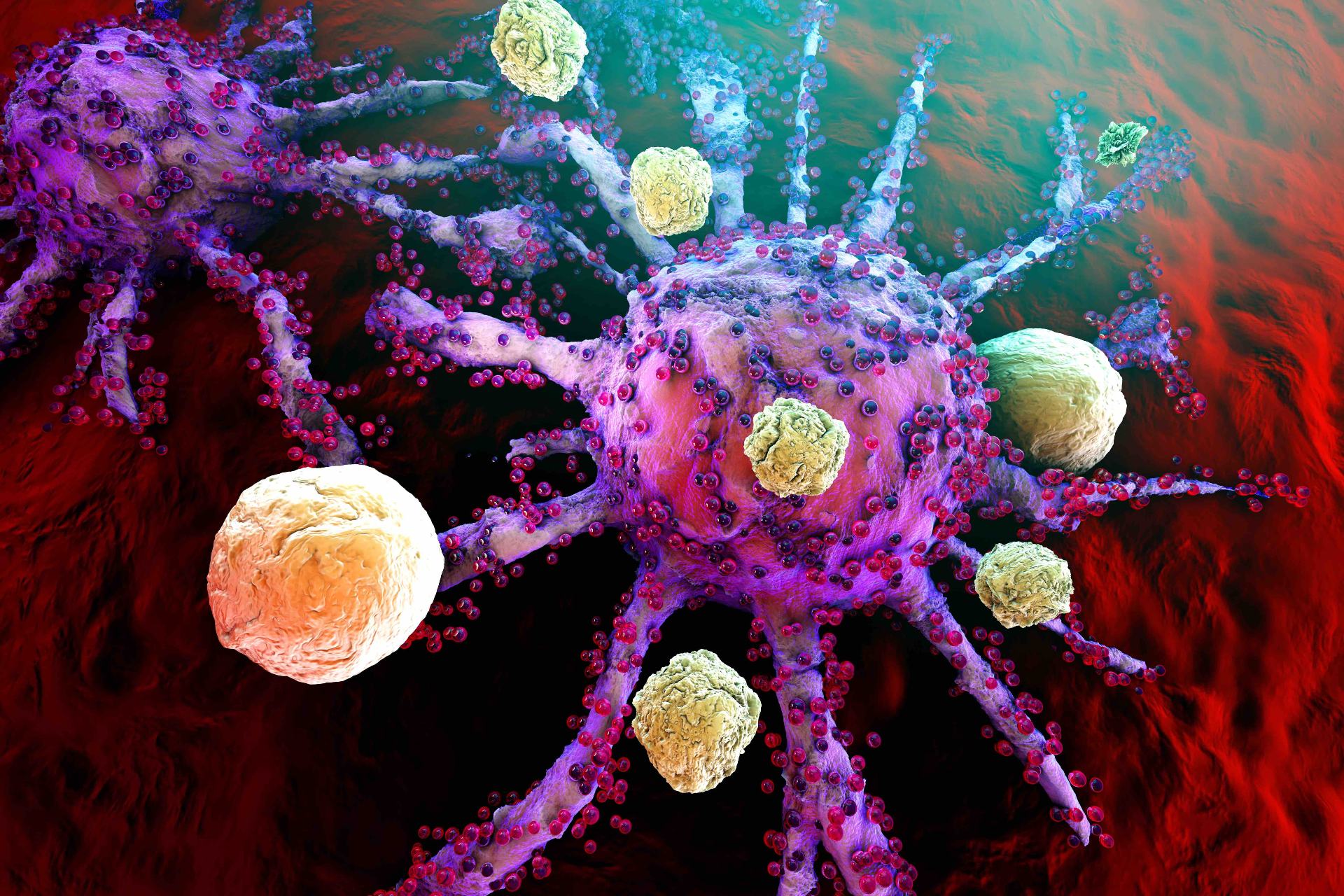- Center on Health Equity & Access
- Clinical
- Health Care Cost
- Health Care Delivery
- Insurance
- Policy
- Technology
- Value-Based Care
Immune System Traits Linked With Remission in Multiple Myeloma
A recent study suggests that a patient’s immune microenvironment plays a key role in the depth and duration of response to multiple myeloma treatment.
Immune cells from the blood and bone marrow of patients with multiple myeloma who experienced sustained minimal residual disease (MRD) negativity showed distinct composition compared with immune cells from those who did not show sustained MRD negativity in a recent study published in Nature Communications.1
Immune cells attacking cancer | Image credit: Spectral-Design - stock.adobe.com

The findings suggest that the immune system plays a significant role in the depth and duration of treatment response among patients with multiple myeloma.
“Our study underscores how critically important the immune system is to patients’ ability to respond favorably—and achieve remission—through current therapies for multiple myeloma,” David Coffey, MD, first study author and hematologic oncologist and researcher at the Sylvester Comprehensive Cancer Center at the University of Miami, said in a press release.2 “Moreover, we discovered that the immune systems of multiple myeloma patients being treated with modern combination therapy could ultimately recover to resemble those of healthy bone-marrow donors if they were able to achieve and sustain [MRD] negativity.”
While survival outcomes have improved for patients with multiple myeloma in recent decades, Coffey and coauthors explained that the role of the immune microenvironment in disease remission is not clear. Therefore, they aimed to determine whether immune system characteristics were associated with long-term treatment response in patients with multiple myeloma receiving lenalidomide maintenance therapy.
The immune microenvironments of 23 patients were comprehensively profiled both before and after 1 year of lenalidomide maintenance therapy using single-cell RNA sequencing and T cell receptor β sequencing of patients’ peripheral blood mononuclear cells (PBMCs), as well as mass cytometry of bone marrow mononuclear cells. The researchers then compared 12 patients who showed sustained MRD negativity (2 consecutive MRD-negative measurements 1 year apart) with 11 patients who either lost or did not show MRD negativity during the study period. Of the patients who did not show sustained MRD negativity, 9 consistently tested positive for MRD and 2 tested negative before converting to positive within the first year of lenalidomide maintenance therapy.
Overall, the median progression-free survival (PFS) was 22 months, and MRD negativity was strongly associated with PFS. All patients who did not experience sustained remission showed disease progression at 24 months, but none of the patients showing sustained MRD negativity progressed during the same time period (log-rank P value = 4.4 × 10−16).
“We found a strong correlation between sustained MRD negativity and prolonged survival,” said senior study author C. Ola Landgren, MD, PhD, chief of the Division of Myeloma at Sylvester.2 “In fact, patients who were treated with modern combination therapy and achieved and sustained MRD negativity for at least two years were highly likely to remain free from multiple myeloma 10 years later.”
The authors controlled for treatment history by comparing patients with sustained vs non-sustained MRD negativity separately based on prior treatment with high-dose melphalan therapy with autologous stem cell transplantation (HDM-ASCT), which was more common among patients with non-sustained MRD negativity. While HDM-ASCT typically prolongs PFS, the severe and prolonged immunosuppression associated with it can affect the immune system’s ability to control the disease.
The composition of immune cells in both blood and bone marrow in patients who experienced sustained MRD was different than that of patients with non-sustained MRD negativity, and immune composition varied based on HDM-ASCT history.
Patients who had not undergone HDM-ASCT and who had sustained MRD negativity also had increased circulating CD4+ T cells, a higher CD4 to CD8 ratio, and fewer TOX -expressing TEM cells. Those with a history of HDM-ASCT and sustained MRD negativity showed more circulating CD8+ T cells and a lower CD4 to CD8 ratio. A lower CD4 to CD8 ratio and increased TOX T-cell expression have both been found in patients with multiple myeloma compared with healthy controls in prior research, the authors explained.
Some differences between the immune cells of patients with sustained vs nonsustained MRD negativity were seemingly not influenced by treatment history—including the frequency of circulating Treg cells, which were found to decline in patients with sustained MRD negativity after a year of maintenance therapy whether they had undergone ASCT or not.
In comparing healthy donor bone marrow with PBMCs from patients with sustained remission and no prior HDM-ASCT, the researchers found a strong, positive correlation between immune cell frequencies. In patients who previously underwent HDM-ASCT, the correlation was not as strong, and those with untreated multiple myeloma were the least similar to healthy bone marrow donors.
“This finding suggests that the immune system of patients achieving sustained MRD negativity could ultimately recover to a healthy state, even in the setting of ongoing treatment with lenalidomide,” the authors wrote.
The study was conducted in a small cohort, and additional research in larger populations is warranted to confirm and expand upon the findings, the authors noted.
“We have already launched a follow-up study designed to characterize myeloma cell biology and host immune cell biology of patients with long-term, sustained MRD negativity versus patients who convert from MRD negativity to MRD positivity,” Landgren said. “Ultimately, we are seeking to understand underlying mechanisms to develop curative strategies.”
Reference
1. Coffey DG, Maura F, Gonzalez-Kozlova E, et al. Immunophenotypic correlates of sustained MRD negativity in patients with multiple myeloma. Nat Commun. 2023;14(1):5335. doi:10.1038/s41467-023-40966-8
2. Immune system plays vital role in longer multiple myeloma remission. Press release. University of Miami. September 8, 2023. Accessed October 6, 2023. https://news.med.miami.edu/immune-system-plays-vital-role-in-longer-multiple-myeloma-remission/
